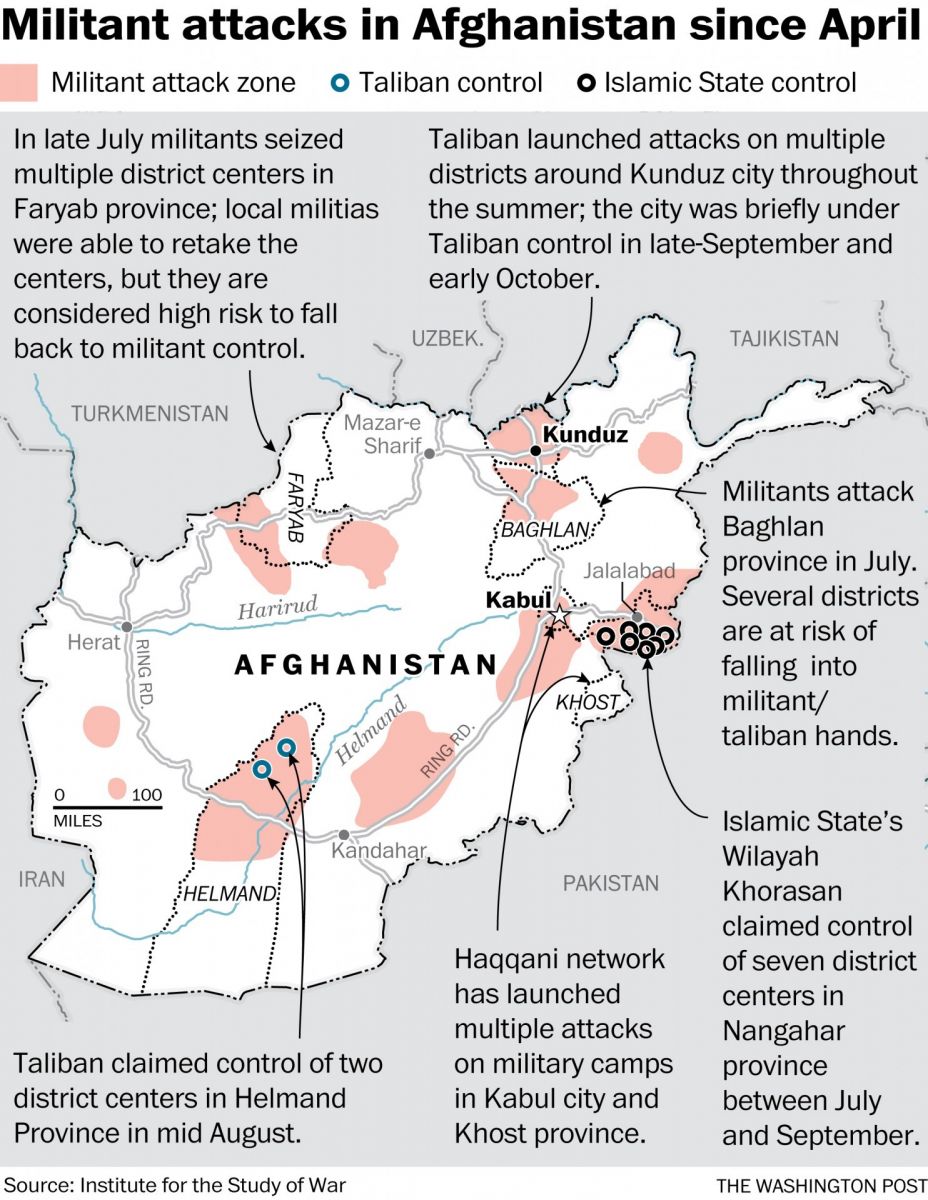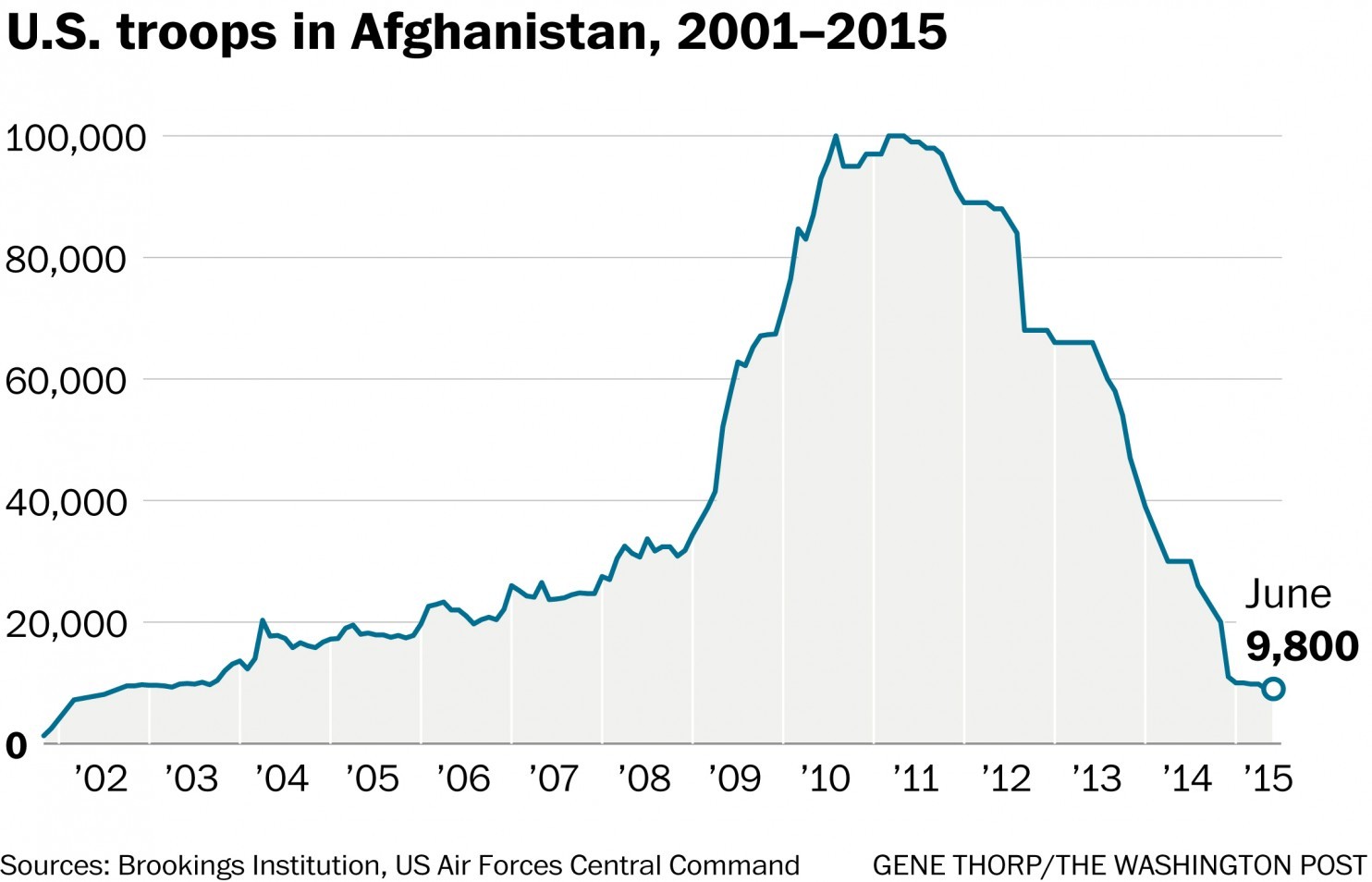
Obama outlines plan to keep 5,500 troops in Afghanistan
Greg Jaffe and Missy Ryan
President Obama said Thursday he will keep 5,500 U.S. troops in Afghanistan into 2017, ending his ambitions to bring home most American forces from that war-torn country before he leaves office.
The president said his decision came after an extensive months-long review that included regular discussions with Afghanistan’s leaders, his national security team and U.S. commanders in the field. The move reflected a painful, if predictable, reality on the ground in Afghanistan, where the Taliban has made gains over the last year as Afghan troops have taken over the vast majority of the fighting.
“Afghan forces are still not as strong as they need to be,” Obama said Thursday morning from the White House, explaining his decision. “Meanwhile, the Taliban has made gains particularly in rural areas and can still launch deadly attacks in cities, including Kabul.”
[The Islamic State is making these Afghans long for the Taliban]
Obama said he will also dramatically slow the pace of the reduction of American forces and plans to maintain the current U.S. force of 9,800 through “most of 2016.” The post-2016 force would still be focused on training and advising the Afghan army, with a special emphasis on its elite counterterror forces. The United States would also maintain a significant counterterrorism capability of drones and Special Operations forces to strike al-Qaeda and other militants who may be plotting attacks against the United States.
The revised troop plans came just weeks after Afghan forces were driven from Kunduz, the first major city to fall to the Taliban since the war began in 2001. Two weeks passed before the Afghans, with some support from U.S. planes and Special Operations advisers, took the city back from the Taliban.
”The bottom line is that in key areas of the country, the security situation is still very fragile, and in some places there’s risk of deterioration,” Obama said.
The president praised the Afghan government, under the leadership of President Ashraf Ghani, as a willing partner, and he lauded the Afghan troops. Both were critical factors in his decision to keep U.S. troops in the country.
“Every single day, Afghan forces are out there fighting and dying to protect their country,” Obama said. “They are not looking to us do it for them.”
The president acknowledged the strain that the last decade of combat has taken on the U.S. military and America’s broader war weariness. “As you are well aware, I do not support the idea of endless war,” he said.
But the potential for Afghanistan to reemerge as a terrorist haven and the prospects for long-term success in the country drove his decision. The continued U.S. presence, Obama said, would give Afghanistan its best chance to achieve “lasting progress.”
Obama’s decision also follows the collapse of the U.S.-trained Iraqi army in northern and western Iraq last summer under pressure from Islamic State militants. White House officials stressed that, when U.S. troops withdrew from Iraq in 2011, the U.S. lacked a capable and willing partner in the Iraqi central government.
In Kabul, Afghan officials welcomed the move as a way to keep pressure on militants as well as give more time to bolster and train Afghan security forces.
“It’s very positive in light of the continued problems that this region is facing,” said Mohammad Daud Sultanzoy, a presidential candidate in 2014 who is now allied with Afghan President Ashraf Ghani. “Our security have shown the will and capability to fight, but we still need the support of our allies, especially the United States.”
Gen. Sayed Malok, a commander in Ghazni province southwest of Kabul, called it a “good decision at the moment but a temporary solution.”
“The permanent solution is to train and equip Afghan forces,” said Malok, whose units faced insurgent attacks this week against the provincial capital.
The U.S. decision is a significant departure from the exit plan that Obama announced in a White House Rose Garden speech in May 2014. In keeping with his promise to “turn the page” on the costly wars launched by his predecessor, Obama said then that he would reduce the U.S. military footprint to around 1,000 troops, all based in Kabul, by the end of 2016.
That minimal force would have prevented the U.S. military from advising Afghan forces in combat or conducting counterterrorism operations against al-Qaeda or threats to the homeland.
The larger force of 5,500 troops is projected to cost about $15 billion a year, or about $5 billion more than the smaller, 1,000-person Kabul-based force would have cost. Although U.S. deaths have fallen off dramatically in recent years, the change will also mean more U.S. casualties. So far this year, 25 American service members and civilians have been killed in the country. “Twenty-five deaths are 25 too many, particularly for the families of the fallen,” Obama said.
But he emphasized that Afghans would continue to take the lead role in the fighting, with Americans providing only advice and some counterterrorism support from bases outside Kabul. “These bases will give us the presence and the reach our forces require to achieve their mission,” he said.
The change in course acknowledges the struggles of the Afghan forces, which are suffering casualties at an “unsustainable” rate, senior military officials said, and have been losing ground throughout Afghanistan to the Taliban. The president’s decision is not directly related to the fall of Kunduz, administration officials said.
“This specific posture has been under consideration for months,” an administration official said. “Obviously we were mindful of the dynamic security situation.”
Obama discussed the decision in a call Wednesday with Ghani, the Afghan president, who has pressed American officials to commit to staying longer in his country.
Under the proposal approved by Obama this week, the U.S. military would retain bases in Kabul, as planned, but also have forces at Bagram air base and at bases outside Kandahar and Jalalabad, the largest cities in Afghanistan’s southern and eastern regions.
The decision is a stark illustration of how persistent militant threats have stood in the way of Obama’s promises to end the ground wars that have dominated U.S. foreign policy since the Sept. 11, 2001, attacks. Last week, U.S. troops launched a major operation against al-Qaeda in Kandahar, the Taliban’s historic heartland. U.S. aircraft conducted 63 strikes in support of Afghan forces who assaulted two militant bases, one of which covered an area of nearly 30 square miles, according to Brig. Gen. Wilson Shoffner, a spokesman for U.S. forces. Those strikes targeted forces aligned with al-Qaeda, the military said.
[After Kunduz, Taliban is now targeting other Afghan cities]
The extended Afghanistan presence could be part of a global network of counterterrorism facilities that, according to a plan championed by Gen. Martin E. Dempsey, former chairman of the Joint Chiefs of Staff, would allow the United States to better manage acute threats without requiring large conventional forces on the ground.
Despite 14 years of military operations by the United States and other NATO nations, Afghanistan remains a dangerous place. This week, even as the Taliban withdrew from Kunduz, the northern city it seized late last month, the militants were advancing on other urban areas.
Al-Qaeda appears to have staked out new ground outside the remote mountain areas along the Afghanistan-Pakistan border, where its fighters have been relegated in recent years.
“That’s what this debate is about: how much we are willing to invest in preventing Afghanistan's return as a serious threat to the region,” said James Cunningham, the U.S. ambassador in Kabul until 2014. “I’m convinced that’s what’s going to happen if we withdraw too rapidly.”
Obama reviewed several proposals for a post-2016 force over the spring and summer before finally settling on the current plan, which was based on a plan brought forward in August by Dempsey, officials said.
Sudarsan Raghavan, Sayed Salahuddin and Mohammad Sharif in Kabul contributed to this report.
https://www.washingtonpost.com/world/national-security/obama-expected-to-announce-new-plan-to-keep-5500-troops-in-afghanistan/2015/10/14/d98f06fa-71d3-11e5-8d93-0af317ed58c9_story.html

